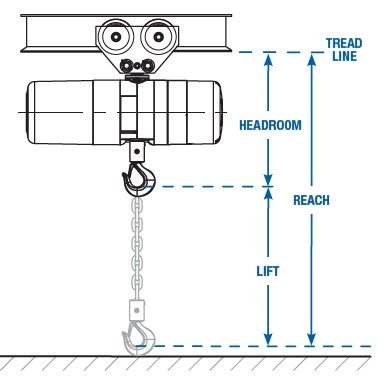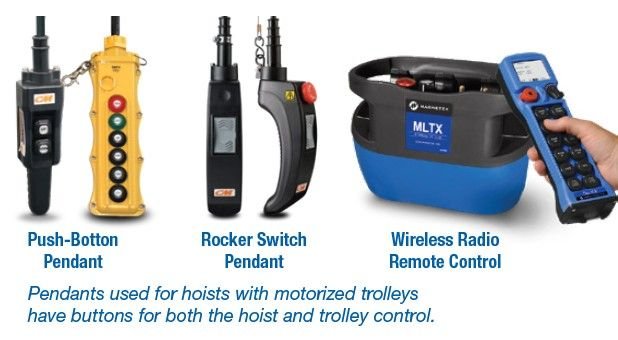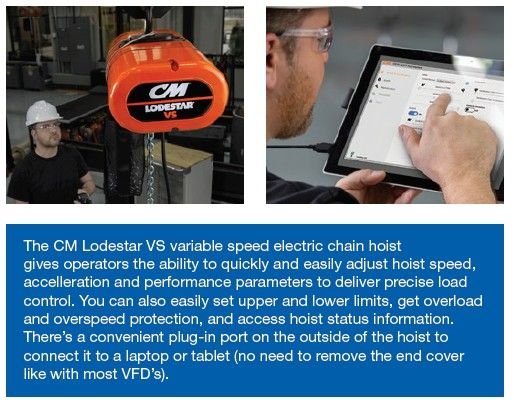Die Wahl des richtigen Hebezeugs ist entscheidend für die Sicherheit und Effizienz von Hebevorgängen. Egal, ob Sie schwere Materialien in einem industriellen Umfeld heben oder empfindliche Gegenstände in einer kontrollierten Umgebung handhaben, bei der Auswahl eines Hebezeugs für Ihren Einsatzzweck sind mehrere wichtige Faktoren zu berücksichtigen. In diesem Leitfaden werden die wichtigsten Aspekte erläutert, damit Sie eine fundierte Entscheidung treffen können.
1. Bestimmen Sie die erforderliche Kapazität
Der erste Schritt bei der Auswahl eines Hebezeugs besteht in der Bestimmung der benötigten Tragfähigkeit. Bei manuellen Hebezeugen sollte die Nenntragfähigkeit mindestens dem Gewicht der schwersten Last entsprechen, die Sie heben möchten. Bei der Auswahl von elektrischen oder pneumatischen Hebezeugen müssen Sie jedoch auch die Mittlere effektive Last (MEL) und wenden Sie den MEL-Faktor von 0,65 an.
Eine detailliertere Analyse der Anforderungen an die Hubkapazität finden Sie unter ASME HST-1, Leistungsstandard für elektrische Kettenzüge. Stellen Sie immer sicher, dass die Tragkraft des Hebezeugs sowohl auf das Lastgewicht als auch auf die strukturellen Einschränkungen Ihres Deckensystems (Ösenaufhängung, Einschienenbahn oder Balken) abgestimmt ist.
2. Auswahl des Federungstyps
Hebezeuge können je nach Anwendungsbedarf in verschiedenen Konfigurationen aufgehängt werden. Zu den üblichen Aufhängungsarten gehören:
- Feste Aufhängung: Das Hebezeug bleibt stehen.
- Laufkatzen-Hebezeug: Dieser Typ ermöglicht die Bewegung entlang eines Schienensystems.
Trolleys können starr oder gelenkig sein und ihre Bewegung kann einfach (Schiebetyp), handbetrieben oder motorgetrieben sein. Die Wahl zwischen fester oder wagenmontierter Aufhängung hängt von der Gestaltung Ihres Arbeitsbereichs und dem erforderlichen Bewegungsgrad ab.
Weitere Informationen zur Auswahl des richtigen Aufhängungstyps für Ihr System finden Sie unter Yale Hebezeuglösungen.
3. Hubhöhe, Reichweite und Kopffreiheit wählen
Bei der Spezifikation Ihres Hebezeugs ist es wichtig, Aufzug, Erreichen, Und Stehhöhe, da diese Faktoren miteinander in Beziehung stehen.
- Aufzug: Dies ist die Distanz, die der Lasthaken von der vollständig abgesenkten in die vollständig angehobene Position zurücklegen kann.
- Erreichen: Der vertikale Abstand zwischen dem Aufhängepunkt des Hebezeugs (z. B. der Öse oder dem Laufkatzenträger) und dem tiefsten Punkt des Hakens.
- Stehhöhe: Der Raum zwischen dem Aufhängepunkt und dem vollständig angehobenen Hakensattel.
Das Verständnis dieser Abmessungen ist entscheidend, um sicherzustellen, dass Ihr Hebezeug in Ihren Betriebsraum passt. Enge Kopffreiheit oder Reichweitenbeschränkungen erfordern möglicherweise eine maßgeschneiderte Hebezeuglösung, die durch die Zusammenarbeit mit Fachleuten bei KRC-Krane.

4. Überlegungen zur Stromversorgung
Verschiedene Hebezeuge benötigen unterschiedliche Energiequellen. Elektrische Hebezeuge arbeiten normalerweise entweder einphasig (120 oder 230 V) oder dreiphasig (208, 230, 460 oder 575 V). Es ist wichtig, die in Ihrer Einrichtung verfügbare Stromversorgung zu überprüfen, bevor Sie eine Entscheidung treffen.
Wenn Sie sich nicht sicher sind, welches Netzteil für Ihren Hebezug am besten geeignet ist, Kontaktieren Sie unsere Experten um Ihnen bei der Auswahl zu helfen.
5. Auswahl des richtigen Steuerungssystems
Hebezeuge können je nach Einsatzzweck und Betriebsanforderungen manuell, elektrisch oder pneumatisch gesteuert werden. Elektrische Hebezeuge sind häufig mit verschiedenen Steuerungsarten ausgestattet:

- Ein- oder zweistufige Schütze: Dies sind die grundlegendsten Steuerungssysteme für elektrische Hebezeuge.
- Frequenzumrichter (VFD): VFD-Systeme passen die Motordrehzahl und das Drehmoment durch Änderung der Eingangsfrequenz an und ermöglichen so eine präzisere Steuerung des Hebezeugbetriebs.
- Geschlossene VFD-Systeme (Flussvektorantriebe): Diese sorgen für eine verbesserte Kontrolle, ermöglichen eine präzise Geschwindigkeitsregulierung und bessere Lastverteilung und verbessern so die Sicherheit und Effizienz deutlich.
6. Auswahl der Hubgeschwindigkeit
Hebezeuge sind mit verschiedenen Hubgeschwindigkeiten erhältlich, die normalerweise zwischen 3 FPM und 64 FPM liegen. Die geeignete Hubgeschwindigkeit hängt von Faktoren wie dem Lastgewicht, der erforderlichen Betriebsgeschwindigkeit und der Gesamtzahl der Zyklen ab, die in einem bestimmten Zeitraum abgeschlossen werden müssen.
Bei schnellen Arbeitsvorgängen können höhere Hubgeschwindigkeiten erforderlich sein, während langsamere Geschwindigkeiten für empfindlichere oder schwerere Hebeaufgaben ideal sein können. Die Drehmomentanforderung ist direkt mit der Hubgeschwindigkeit verknüpft und die Motorleistung muss entsprechend angegeben werden.

7. Auswahl des richtigen Hebezeugs für spezielle Umgebungen
Standardhebezeuge sind für normale Betriebsbedingungen ausgelegt. Wenn Sie jedoch in Umgebungen mit extremen Temperaturen, im Freien oder in korrosiver Atmosphäre arbeiten, benötigen Sie möglicherweise ein Hebezeug mit speziellen Modifikationen. Hebezeuge für Meeresumwelt, saubere Zimmer, oder Waschbereiche Sie bieten den notwendigen Schutz und die Funktionen, um einen sicheren und zuverlässigen Betrieb zu gewährleisten.
Wenn Sie in speziellen Umgebungen arbeiten, kontaktieren Sie KRC-Krane für maßgeschneiderte Hebelösungen, die Ihren Anforderungen entsprechen.

8. Maßbeschränkungen und Raumplanung
Bevor Sie sich für einen Hebezeug entscheiden, sollten Sie den verfügbaren Platz für die Installation berücksichtigen. Wichtige Überlegungen zu den Abmessungen sind:
- Durchfahrtshöhe: Stellen Sie sicher, dass über dem Hebezeug genügend Platz für einen sicheren Betrieb vorhanden ist.
- Seitlicher Abstand: Stellen Sie sicher, dass entlang der Einschienenbahn oder des Kranträgers ausreichend Platz vorhanden ist.
- Endanflug: Dies ist der Abstand zwischen der Mittellinie des Hebehakens und dem Ende des Balkens oder der Laufbahn.
9.Bestimmen der erforderlichen Betriebsklasse
Der Amerikanische Gesellschaft der Ingenieure (ASME) und die Institut für Hebezeughersteller (HMI) haben Standards für Hebezeuge entwickelt und veröffentlicht, darunter auch Leistungsklassifizierungen, um Benutzern bei der Auswahl der richtigen Ausrüstung für ihre Anforderungen zu helfen. Diese Leistungsklasseneinstufungen werden von mehreren Faktoren bestimmt, wie zum Beispiel:
| Hebezeugpflicht | Anwendungen | Gleichmäßigkeitsverteilung Arbeitsperioden | Unregelmäßige Arbeitsperioden | ||
|---|---|---|---|---|---|
| Max. Einschaltdauer Min./Std. | Max. # Starts/Std. | Max. Einschaltdauer ab Kaltstart | Max. # Starts | ||
| H1 | Die Handhabung erfolgt selten, die Lasthäufigkeit nähert sich der Kapazität und der Hebezeug steht zwischen den Einsätzen lange Zeit im Leerlauf. | 7,5 Minuten (12,51 TP3T) | 75 | 15 Minuten. | 100 |
| H2 | Lasten und Auslastung zufällig verteilt; Nennlasten werden selten gehandhabt. Gesamtlaufzeit nicht über 12,51 TP3T der Arbeitsperiode. | 7,5 Minuten (12,51 TP3T) | 75 | 15 Minuten. | 100 |
| H3 | Lasten und Auslastung zufällig verteilt. Gesamtlaufzeit nicht über 25% der Arbeitsperiode. | 15 Minuten (25%) | 150 | 30 Minuten. | 200 |
| H4 | Handhabung großer Mengen schwerer Lasten, häufig nahe der Nennlast. Gesamtlaufzeit nicht über 501 TP3T des Arbeitszeitraums. | 30 Minuten (50%) | 300 | 30 Minuten. | 300 |
| H5 | Die Geräte werden häufig in der Kabine bedient. Arbeitszyklen, die einem Dauerbetrieb nahe kommen, sind häufig erforderlich. | 60 Minuten (100%) | 600 | N / A | N / A |
Die hier aufgeführte Tabelle enthält die Hubwerk-Arbeitszyklen, vermittelt einen klaren Überblick über die Betriebszeitwerte für verschiedene Hebezeug-Arbeitszyklen. Die Tabelle hilft Benutzern, die für ihre Anwendungen am besten geeignete Betriebsklasse anhand von Faktoren wie Arbeitsperioden, Häufigkeit der Lasthandhabung und maximaler Betriebszeit zu ermitteln.
10. Abschließende Überlegungen und Expertenhilfe
Bei der Auswahl des richtigen Hebezeugs müssen mehrere Faktoren berücksichtigt werden, darunter Kapazität, Aufhängungsart, Stromversorgung, Geschwindigkeit und Betriebsanforderungen. KRC-Kranebieten wir kompetente Beratung und eine breite Palette an Hebezeugen, die auf Ihre spezifischen Anforderungen zugeschnitten sind. Unser Team kann Sie durch jeden Schritt des Auswahlprozesses führen und sicherstellen, dass Sie das beste Hebezeug für Ihre Anwendung auswählen.
Für eine individuellere Beratung bei der Auswahl Ihres Hebezeugs kontaktieren Sie bitte unseren Anwendungsexperten.
Wenn Sie die in diesem Leitfaden beschriebenen Faktoren sorgfältig berücksichtigen, können Sie bei der Auswahl eines Hebezeugs eine fundierte Entscheidung treffen. Die richtige Auswahl des Hebezeugs erhöht nicht nur die Sicherheit und Effizienz, sondern maximiert auch die Lebensdauer der Ausrüstung. Weitere Informationen zu Hebezeugen und Deckenliftlösungen finden Sie in unseren umfassenden Ressourcen unter Yale Hebezeug.